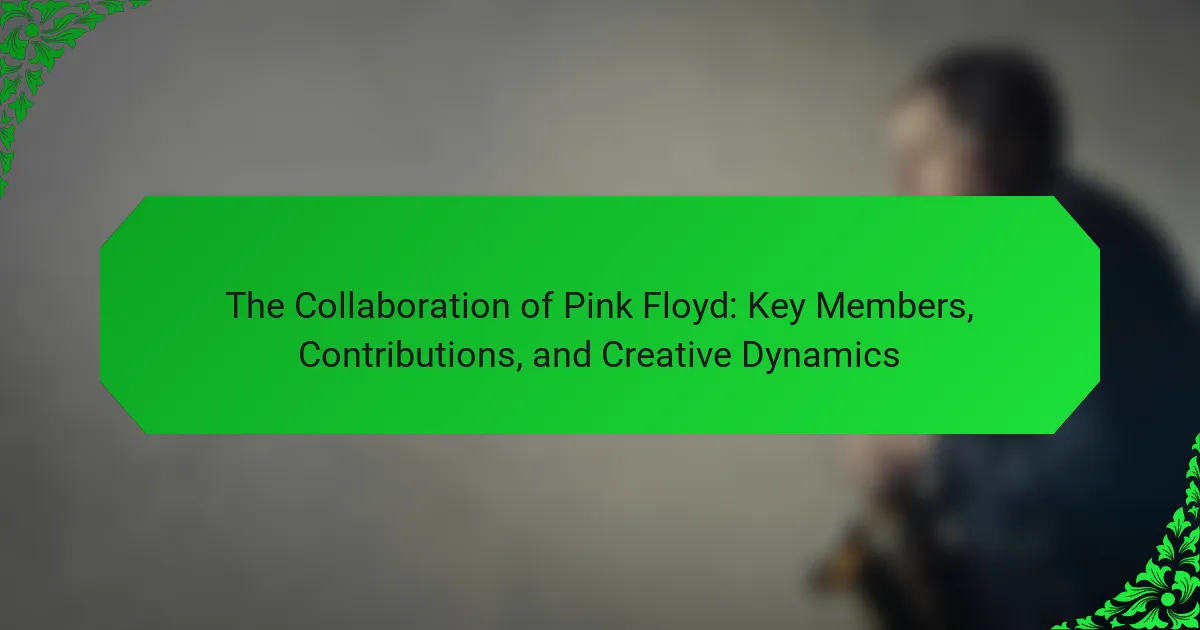Pink Floyd, a seminal rock band, is comprised of key members Roger Waters, David Gilmour, Richard Wright, and Nick Mason. Each member contributed uniquely to the band’s identity, with Waters as the primary lyricist, Gilmour providing guitar and vocals, Wright on keyboards, and Mason on drums. The band is renowned for its innovative soundscapes, conceptual albums, and elaborate live performances, particularly in influential works like “The Dark Side of the Moon” and “The Wall.” Pink Floyd’s exploration of philosophical themes and pioneering use of studio technology have left a profound impact on music, inspiring countless artists and reshaping the landscape of progressive rock. This article examines the collaborative dynamics and creative contributions of Pink Floyd’s members, highlighting their collective influence on the music industry.

Who are the key members of Pink Floyd?
The key members of Pink Floyd are Roger Waters, David Gilmour, Richard Wright, and Nick Mason. Roger Waters was the band’s primary lyricist and conceptual leader. David Gilmour contributed guitar work and vocals, becoming the face of the band in later years. Richard Wright played keyboards and provided backing vocals, contributing to the band’s sound. Nick Mason was the drummer, known for his distinctive style. These four members shaped Pink Floyd’s music and identity, particularly during their most influential albums like “The Dark Side of the Moon” and “The Wall.”
What roles did each member play in the band’s formation?
The roles of each member in Pink Floyd’s formation were distinct and vital. Syd Barrett was the founding member and primary songwriter. He played guitar and contributed to the band’s early creative direction. Roger Waters joined as a bassist and lyricist, shaping the band’s thematic elements. Richard Wright served as the keyboardist and contributed to the band’s soundscapes. Nick Mason was the drummer, providing rhythmic foundation and structural support. Each member’s contributions were essential in establishing Pink Floyd’s unique style and identity. Their collaboration set the stage for the band’s innovative approach to music.
How did Syd Barrett’s vision shape the early sound of Pink Floyd?
Syd Barrett’s vision significantly shaped the early sound of Pink Floyd. His creative influence introduced elements of psychedelia and experimentalism. Barrett’s songwriting featured surreal lyrics and unconventional song structures. This approach created a unique atmosphere in tracks like “Astronomy Domine” and “Interstellar Overdrive.” His use of distortion and effects on guitar added a distinct sonic texture. Barrett’s whimsical and often introspective themes set the tone for the band’s early identity. His artistic direction was pivotal in defining the band’s sound before his departure. Ultimately, Barrett’s contributions laid the groundwork for Pink Floyd’s evolution into a leading force in progressive rock.
What contributions did Roger Waters make to the band’s lyrical depth?
Roger Waters significantly enhanced Pink Floyd’s lyrical depth through his introspective and often political themes. His writing tackled complex subjects such as alienation, war, and the human condition. Waters’ lyrics often drew from personal experiences, providing authenticity and emotional resonance. For example, the album “The Wall” explores themes of isolation and trauma, reflecting his own life and broader societal issues. His collaboration with other band members, particularly in the conceptual framework of albums, added layers of narrative and meaning. Waters’ ability to blend personal and universal themes made the band’s work profoundly impactful and thought-provoking.
How did David Gilmour’s guitar work define Pink Floyd’s musical identity?
David Gilmour’s guitar work defined Pink Floyd’s musical identity through its emotive solos and innovative techniques. His use of sustain and expressive bending created a signature sound. Gilmour often combined melody with atmosphere, enhancing the band’s progressive rock style. His solos in tracks like “Comfortably Numb” and “Time” exemplify this blend of emotion and technical skill. The iconic sound of his guitar is characterized by the use of effects like delay and reverb. These elements contributed to the band’s exploration of themes such as alienation and introspection. Gilmour’s ability to evoke deep feelings through his playing set Pink Floyd apart from other bands. His contributions solidified the band’s status as pioneers in the music industry.
What impact did Richard Wright have on the band’s keyboard arrangements?
Richard Wright significantly shaped Pink Floyd’s keyboard arrangements. His use of synthesizers added depth and texture to the band’s sound. Wright’s innovative chord progressions created atmospheric layers in songs. He often combined classical influences with rock elements. This blend distinguished Pink Floyd’s music from other bands. His contributions were pivotal in albums like “The Dark Side of the Moon.” The album featured intricate keyboard work that enhanced its conceptual themes. Wright’s creativity in arrangement influenced the overall sonic landscape of the band.
How did Nick Mason’s drumming style influence the band’s rhythm?
Nick Mason’s drumming style significantly influenced Pink Floyd’s rhythm by providing a unique blend of precision and improvisation. His use of varied tempos and unconventional time signatures contributed to the band’s experimental sound. Mason often employed syncopation, creating rhythmic complexity that enhanced the musical texture. His incorporation of jazz elements added a distinctive flair to the band’s compositions. For example, in tracks like “Money,” Mason’s intricate drum patterns established a compelling groove. This approach allowed for greater musical exploration within the band’s progressive rock framework. Overall, Mason’s drumming was essential in shaping Pink Floyd’s rhythmic identity.
What were the dynamics among the band members?
The dynamics among Pink Floyd’s band members were complex and often contentious. Roger Waters and David Gilmour had a particularly tumultuous relationship, marked by creative disagreements. Waters typically drove the band’s conceptual direction, while Gilmour focused on musical composition and guitar work. Richard Wright and Nick Mason often played mediating roles, supporting both sides during conflicts. Over time, Waters’ increasing dominance led to tensions, resulting in his departure in 1985. This shift changed the band’s dynamics significantly, allowing Gilmour to take creative control. The band’s internal struggles were also reflected in their music, particularly in albums like “The Wall.” Thus, the interplay of collaboration and conflict shaped Pink Floyd’s evolution and sound.
How did collaboration affect the songwriting process?
Collaboration significantly enhanced the songwriting process for Pink Floyd. It allowed for diverse musical ideas and perspectives. Each member contributed unique strengths to the creative dynamic. For instance, Roger Waters often focused on lyrical depth while David Gilmour emphasized melody and guitar work. This synergy led to complex compositions that blended various styles. The collaborative environment encouraged experimentation with sound and structure. Notably, albums like “The Dark Side of the Moon” exemplified this collaborative creativity. The result was a rich, innovative sound that defined their legacy in rock music.
What challenges did the band face in maintaining creative harmony?
The band Pink Floyd faced significant challenges in maintaining creative harmony. Differing artistic visions among members often led to conflicts. Roger Waters and David Gilmour had contrasting approaches to songwriting. Waters favored conceptual and political themes, while Gilmour preferred more personal and melodic content. Tensions escalated during the production of albums like “The Wall.” The emotional strain from personal issues also contributed to discord within the group. Additionally, the pressure of commercial success created further stress. These factors ultimately affected their collaborative efforts and led to a decline in unity.

What are the major contributions of Pink Floyd to music?
Pink Floyd made significant contributions to music through innovative soundscapes and conceptual albums. They pioneered the use of synthesizers and studio effects, shaping the sound of progressive rock. Their album “The Dark Side of the Moon” remains one of the best-selling albums of all time, noted for its thematic depth and production techniques. The band introduced elaborate live shows that combined music with visual arts, influencing future concert experiences. Their exploration of philosophical and existential themes in lyrics set a new standard for songwriting. Pink Floyd’s influence can be seen in various genres, inspiring countless artists and bands. Their experimental approach to music and storytelling has left a lasting legacy in the music industry.
How did their albums redefine the concept of a rock album?
Pink Floyd’s albums redefined the concept of a rock album through innovative storytelling and sonic experimentation. Their work, particularly “The Dark Side of the Moon,” introduced the idea of a cohesive thematic experience. This album, released in 1973, features seamless transitions between tracks, creating a continuous listening experience. The use of sound effects and varied instrumentation expanded the traditional boundaries of rock music. Additionally, “The Wall” presented a rock opera format, combining narrative depth with musical composition. These elements elevated rock albums to artistic statements rather than mere collections of songs. Pink Floyd’s approach influenced countless artists and reshaped the expectations of what a rock album could achieve.
What themes are prevalent in Pink Floyd’s discography?
Prevalent themes in Pink Floyd’s discography include alienation, mental health, and the passage of time. The band often explores the human experience and existentialism. Their lyrics reflect feelings of isolation and disconnection. The album “The Wall” addresses trauma and the impact of fame. “Wish You Were Here” deals with absence and loss. The theme of societal critique appears in “Animals” and “The Final Cut.” Pink Floyd’s music often incorporates philosophical inquiries and critiques of modern life. These themes resonate deeply with audiences, contributing to their lasting legacy.
How did their use of technology enhance their sound?
Pink Floyd’s use of technology significantly enhanced their sound through innovative recording techniques and equipment. They utilized multi-track recording to layer sounds, allowing for complex arrangements. The use of synthesizers introduced new textures and effects in their music. Their incorporation of tape loops created unique soundscapes that were previously unattainable. The band also employed advanced studio effects, such as reverb and delay, to enrich their audio. Notably, the album “The Dark Side of the Moon” showcased their pioneering use of sound engineering. This album became a benchmark for high-fidelity sound production. Overall, technology played a crucial role in shaping Pink Floyd’s distinctive sonic identity.
What influence did Pink Floyd have on other artists?
Pink Floyd significantly influenced numerous artists across various genres. Their innovative use of sound and concept albums set a new standard in music. Bands like Radiohead and Muse cite Pink Floyd as a major inspiration for their experimental approaches. Their album “The Dark Side of the Moon” is often referenced for its thematic depth and sonic experimentation. Artists such as David Bowie and U2 have acknowledged the impact of Pink Floyd’s theatrical performances on their own stage shows. The band’s blending of rock with philosophical themes has inspired countless lyricists. Additionally, their pioneering work in studio techniques influenced producers and musicians alike. Pink Floyd’s legacy continues to resonate in contemporary music, shaping the creative direction of new generations.
In what ways did they inspire the progressive rock genre?
Pink Floyd inspired the progressive rock genre through their innovative use of sound and concept albums. They pioneered the integration of elaborate storytelling with music. Their album “The Dark Side of the Moon” featured seamless transitions between tracks, enhancing the listening experience. The band utilized advanced studio techniques, including multi-layered sound effects and synthesizers. Their music often incorporated philosophical themes and social commentary, elevating the genre’s artistic aspirations. Live performances included elaborate visual elements, contributing to the immersive experience of their music. Pink Floyd’s influence is evident in the works of later progressive rock bands, who adopted similar thematic and musical complexity. Their approach redefined the boundaries of rock music, making it more than just entertainment.
How did their artistic vision impact modern music culture?
Pink Floyd’s artistic vision profoundly shaped modern music culture by pioneering the concept of the concept album. Their album “The Dark Side of the Moon” integrated music with thematic storytelling, influencing countless artists. The band’s use of sound effects and innovative studio techniques set new standards for production quality. Their exploration of complex themes like mental health and existentialism resonated with audiences, pushing boundaries in lyrical content. Live performances incorporated elaborate visual elements, establishing a blueprint for future concerts. Pink Floyd’s influence is evident in genres such as progressive rock and electronic music. Their legacy continues to inspire musicians and bands to experiment with sound and narrative in their work.

What creative dynamics shaped Pink Floyd’s evolution?
Pink Floyd’s evolution was shaped by innovative songwriting, experimental sound, and visual artistry. The band members, particularly Syd Barrett, Roger Waters, and David Gilmour, contributed distinct musical styles. Barrett’s early influence brought psychedelic elements, while Waters introduced conceptual themes in albums like “The Wall.” Gilmour’s guitar work added emotional depth and technical proficiency. Collaborative dynamics allowed for the blending of diverse ideas. The band’s experimentation with studio technology, especially in “The Dark Side of the Moon,” redefined music production. Their live performances incorporated elaborate visual effects, enhancing the overall experience. These factors collectively influenced their unique identity and artistic direction.
How did personal relationships affect the band’s creative output?
Personal relationships significantly influenced Pink Floyd’s creative output. The dynamics between band members shaped their songwriting and musical direction. For instance, the tension between Roger Waters and David Gilmour led to both conflict and innovation. This friction often resulted in powerful lyrics and complex compositions. Additionally, the camaraderie among members fostered a collaborative atmosphere. Collaborative efforts produced iconic albums like “The Dark Side of the Moon.” Emotional experiences shared within the group inspired much of their lyrical content. Ultimately, personal relationships were a driving force behind their artistic evolution.
What role did conflicts play in their musical development?
Conflicts played a significant role in Pink Floyd’s musical development. Creative tensions often sparked innovation within the band. Disagreements among members led to diverse musical explorations. For example, the clash between Roger Waters and David Gilmour shaped the band’s lyrical and musical direction. Waters’ conceptual vision contrasted with Gilmour’s melodic focus. This friction resulted in landmark albums like “The Wall” and “Dark Side of the Moon.” The conflicts ultimately pushed the band to explore complex themes and soundscapes. These dynamics were integral to their evolution as artists.
How did the band’s lineup changes influence their sound?
Lineup changes in Pink Floyd significantly influenced their sound. The departure of Syd Barrett led to a shift from psychedelic rock to more experimental music. His absence allowed for greater creative input from Roger Waters and David Gilmour. This change resulted in a darker, more conceptual approach, particularly evident in albums like “The Dark Side of the Moon.” The addition of Gilmour introduced a focus on guitar solos and melodic elements. Waters’ evolving vision emphasized lyrical depth and thematic coherence. The eventual departure of Waters shifted the band’s dynamic again, leading to a more commercial sound in later works. Each lineup change brought distinct influences that shaped the band’s musical trajectory.
What collaborative projects highlight their creative synergy?
The collaborative projects that highlight Pink Floyd’s creative synergy include “The Dark Side of the Moon” and “The Wall.” “The Dark Side of the Moon” was released in 1973 and became a landmark album, showcasing the band’s innovative sound and thematic depth. It features seamless transitions between tracks and explores complex themes of mental health and societal issues. The album spent over 900 weeks on the Billboard 200 chart, demonstrating its lasting impact.
“The Wall,” released in 1979, is another significant project that illustrates their creative collaboration. It is a rock opera that tells a cohesive story through its songs. The album addresses themes of isolation and personal struggle. It was accompanied by a successful film adaptation, further solidifying its cultural relevance. Both projects exemplify the band’s ability to blend music, lyrics, and visual art, showcasing their unique synergy.
Which live performances showcased their innovative approach?
The live performances of Pink Floyd that showcased their innovative approach include “The Dark Side of the Moon” tour and “The Wall” tour. These performances integrated elaborate visual effects and conceptual themes. The use of synchronized light shows and large-scale projections was groundbreaking. During “The Dark Side of the Moon,” the band introduced innovative sound technology. This included quadraphonic sound systems that enhanced the auditory experience. “The Wall” tour featured a massive wall built on stage, symbolizing isolation. These performances set new standards in live music production. They influenced future generations of artists and live shows.
How did their film projects reflect their artistic vision?
Pink Floyd’s film projects reflected their artistic vision through innovative visuals and thematic depth. The band’s 1972 film “Pink Floyd: Live at Pompeii” showcased their music in a visually striking, non-narrative format. This choice emphasized the emotional and atmospheric qualities of their sound. The film’s use of surreal imagery aligned with their experimental approach to music. Additionally, “The Wall,” released in 1982, combined narrative storytelling with powerful visual elements. It explored themes of isolation and alienation, mirroring the band’s own experiences. These projects demonstrated their commitment to pushing artistic boundaries and creating immersive experiences.
What lessons can be learned from Pink Floyd’s collaboration style?
Pink Floyd’s collaboration style teaches the importance of diverse contributions in creativity. Each member brought unique skills to the group. Roger Waters contributed powerful lyrics and concepts. David Gilmour added distinctive guitar work and melodies. Richard Wright provided atmospheric keyboard sounds. Nick Mason contributed rhythmic drumming and production insights. Their collaboration often involved open communication and mutual respect. This approach led to innovative albums like “The Dark Side of the Moon.” The success of their collaboration underscores the value of blending different artistic perspectives.
The main entity of the article is Pink Floyd, a prominent rock band known for their innovative music and conceptual albums. The article provides an overview of the key members—Roger Waters, David Gilmour, Richard Wright, and Nick Mason—and their distinct contributions to the band’s formation and sound. It explores how Syd Barrett’s early vision influenced their style, the dynamics among members, and the impact of collaboration on their songwriting process. Additionally, it highlights the band’s significant contributions to music, including their thematic exploration, use of technology, and the influence they have had on other artists and the progressive rock genre.
